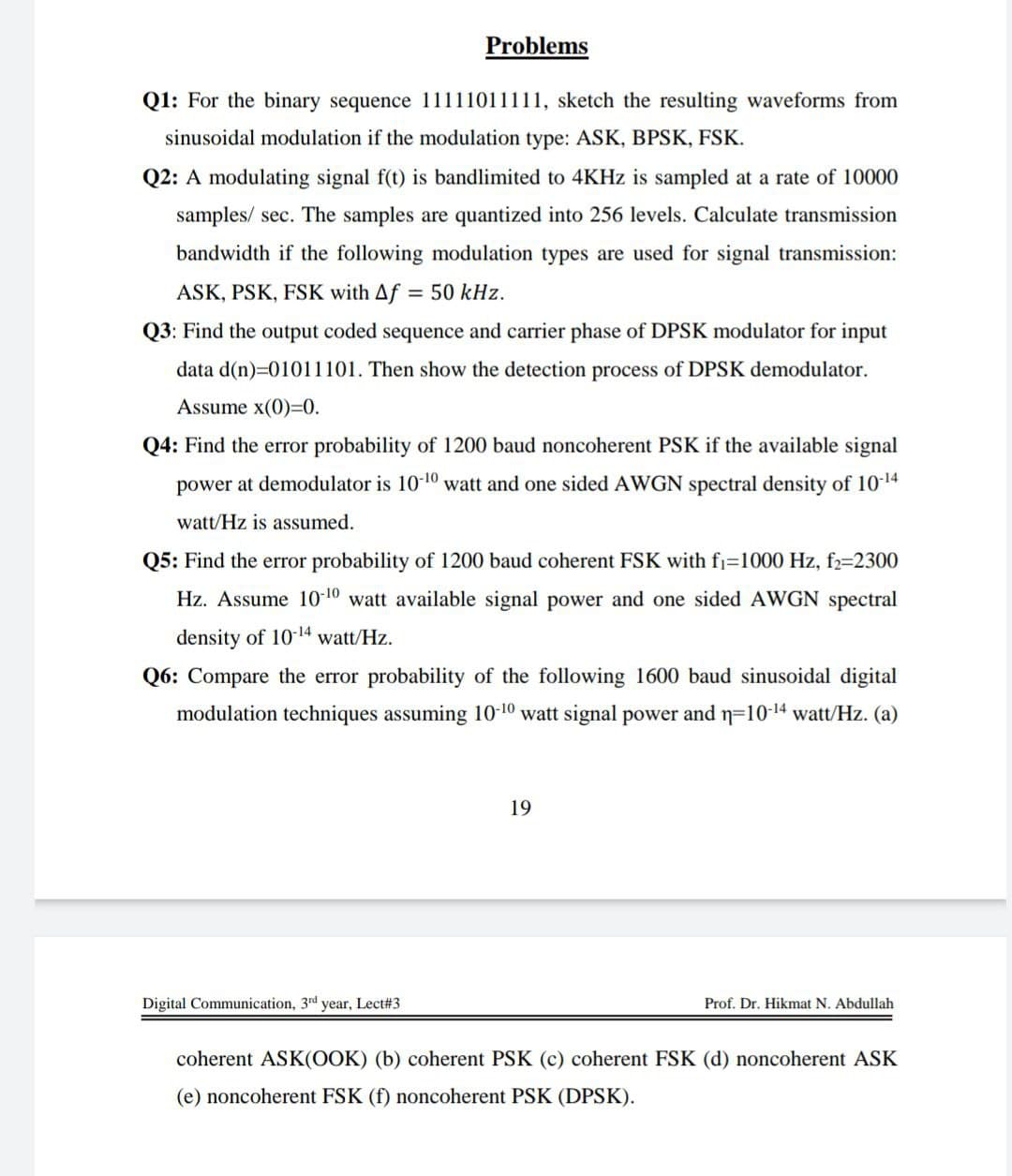Q1: For the binary sequence 11111011111, sketch the resulting waveforms from sinusoidal modulation if the modulation type: ASK, BPSK, FSK. Q2: A modulating signal f(t) is bandlimited to 4KHz is sampled at a rate of 10000 samples/ sec. The samples are quantized into 256 levels. Calculate transmission bandwidth if the following modulation types are used for signal transmission: ASK, PSK, FSK with Af = 50 kHz. Q3: Find the output coded sequence and carrier phase of DPSK modulator for input data d(n)=01011101. Then show the detection process of DPSK demodulator. Assume x(0)=0. Q4: Find the error probability of 1200 baud noncoherent PSK if the available signal power at demodulator is 10-10 watt and one sided AWGN spectral density of 10-14 watt/Hz is assumed. Q5: Find the error probability of 1200 baud coherent FSK with fi=1000 Hz, f2=2300 Hz. Assume 10-¹0 watt available signal power and one sided AWGN spectral density of 10-14 watt/Hz. Q6: Compare the error probability of the following 1600 baud sinusoidal digital modulation techniques assuming 10-10 watt signal power and n-10-14 watt/Hz. (a) 19 Digital Communication, 3rd year, Lect#3 Prof. Dr. Hikmat N. Abdullah coherent ASK(OOK) (b) coherent PSK (c) coherent FSK (d) noncoherent ASK (e) noncoherent FSK (f) noncoherent PSK (DPSK).
Q1: For the binary sequence 11111011111, sketch the resulting waveforms from sinusoidal modulation if the modulation type: ASK, BPSK, FSK. Q2: A modulating signal f(t) is bandlimited to 4KHz is sampled at a rate of 10000 samples/ sec. The samples are quantized into 256 levels. Calculate transmission bandwidth if the following modulation types are used for signal transmission: ASK, PSK, FSK with Af = 50 kHz. Q3: Find the output coded sequence and carrier phase of DPSK modulator for input data d(n)=01011101. Then show the detection process of DPSK demodulator. Assume x(0)=0. Q4: Find the error probability of 1200 baud noncoherent PSK if the available signal power at demodulator is 10-10 watt and one sided AWGN spectral density of 10-14 watt/Hz is assumed. Q5: Find the error probability of 1200 baud coherent FSK with fi=1000 Hz, f2=2300 Hz. Assume 10-¹0 watt available signal power and one sided AWGN spectral density of 10-14 watt/Hz. Q6: Compare the error probability of the following 1600 baud sinusoidal digital modulation techniques assuming 10-10 watt signal power and n-10-14 watt/Hz. (a) 19 Digital Communication, 3rd year, Lect#3 Prof. Dr. Hikmat N. Abdullah coherent ASK(OOK) (b) coherent PSK (c) coherent FSK (d) noncoherent ASK (e) noncoherent FSK (f) noncoherent PSK (DPSK).
Introductory Circuit Analysis (13th Edition)
13th Edition
ISBN:9780133923605
Author:Robert L. Boylestad
Publisher:Robert L. Boylestad
Chapter1: Introduction
Section: Chapter Questions
Problem 1P: Visit your local library (at school or home) and describe the extent to which it provides literature...
Related questions
Question

Transcribed Image Text:Problems
Q1: For the binary sequence 11111011111, sketch the resulting waveforms from
sinusoidal modulation if the modulation type: ASK, BPSK, FSK.
Q2: A modulating signal f(t) is bandlimited to 4KHz is sampled at a rate of 10000
samples/ sec. The samples are quantized into 256 levels. Calculate transmission
bandwidth if the following modulation types are used for signal transmission:
ASK, PSK, FSK with Af = 50 kHz.
Q3: Find the output coded sequence and carrier phase of DPSK modulator for input
data d(n)=01011101. Then show the detection process of DPSK demodulator.
Assume x(0)=0.
Q4: Find the error probability of 1200 baud noncoherent PSK if the available signal
power at demodulator is 10-10 watt and one sided AWGN spectral density of 10-14
watt/Hz is assumed.
Q5: Find the error probability of 1200 baud coherent FSK with f₁=1000 Hz, f2=2300
Hz. Assume 10-¹0 watt available signal power and one sided AWGN spectral
density of 10-14 watt/Hz.
Q6: Compare the error probability of the following 1600 baud sinusoidal digital
modulation techniques assuming 10-10 watt signal power and n=10-¹4 watt/Hz. (a)
19
Digital Communication, 3rd year, Lect#3
Prof. Dr. Hikmat N. Abdullah
coherent ASK(OOK) (b) coherent PSK (c) coherent FSK (d) noncoherent ASK
(e) noncoherent FSK (f) noncoherent PSK (DPSK).
Expert Solution
This question has been solved!
Explore an expertly crafted, step-by-step solution for a thorough understanding of key concepts.
Step by step
Solved in 2 steps with 1 images

Knowledge Booster
Learn more about
Need a deep-dive on the concept behind this application? Look no further. Learn more about this topic, electrical-engineering and related others by exploring similar questions and additional content below.Recommended textbooks for you

Introductory Circuit Analysis (13th Edition)
Electrical Engineering
ISBN:
9780133923605
Author:
Robert L. Boylestad
Publisher:
PEARSON

Delmar's Standard Textbook Of Electricity
Electrical Engineering
ISBN:
9781337900348
Author:
Stephen L. Herman
Publisher:
Cengage Learning

Programmable Logic Controllers
Electrical Engineering
ISBN:
9780073373843
Author:
Frank D. Petruzella
Publisher:
McGraw-Hill Education

Introductory Circuit Analysis (13th Edition)
Electrical Engineering
ISBN:
9780133923605
Author:
Robert L. Boylestad
Publisher:
PEARSON

Delmar's Standard Textbook Of Electricity
Electrical Engineering
ISBN:
9781337900348
Author:
Stephen L. Herman
Publisher:
Cengage Learning

Programmable Logic Controllers
Electrical Engineering
ISBN:
9780073373843
Author:
Frank D. Petruzella
Publisher:
McGraw-Hill Education

Fundamentals of Electric Circuits
Electrical Engineering
ISBN:
9780078028229
Author:
Charles K Alexander, Matthew Sadiku
Publisher:
McGraw-Hill Education

Electric Circuits. (11th Edition)
Electrical Engineering
ISBN:
9780134746968
Author:
James W. Nilsson, Susan Riedel
Publisher:
PEARSON

Engineering Electromagnetics
Electrical Engineering
ISBN:
9780078028151
Author:
Hayt, William H. (william Hart), Jr, BUCK, John A.
Publisher:
Mcgraw-hill Education,